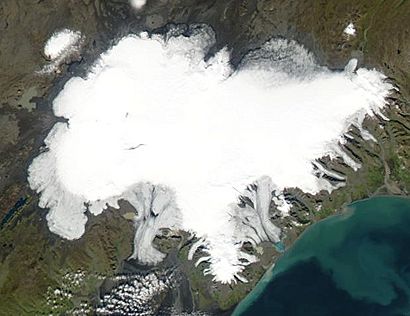Ice cap facts for kids
An ice cap is a large dome-shaped mass of ice. It covers a land area smaller than 50,000 square kilometers (about 19,000 square miles). Think of it like a giant icy hat on top of mountains or high land. If the ice mass is bigger than 50,000 square kilometers, it's called an ice sheet.
What are Ice Caps?
Ice caps are special because they aren't limited by the shape of the land underneath them. They just spread out over mountains and valleys. This is different from an ice field, which is shaped by the land. The highest part of an ice cap is usually in the middle, like the top of a dome. From this high point, the ice slowly flows outwards towards the edges.
Ice caps have a big impact on the land they cover. As they move, they can carve out the land, creating new shapes. When an ice cap melts or shrinks, you can see the marks it left behind. Many large lakes, like the Great Lakes in North America, and many valleys were formed by the slow, powerful movement of ice over thousands of years.
On Earth, there's a huge amount of ice, about 30 million cubic kilometers (7.2 million cubic miles) in total. The temperature inside an ice cap is very cold, usually between -15 and -20 degrees Celsius (5 to -4 degrees Fahrenheit).
Types of Ice Caps
Sometimes, very large areas of ice in cold regions are called polar ice caps. Even though they are bigger than the official size for an ice cap, many people use this name.
Vatnajökull in Iceland is a great example of an ice cap. It's one of the largest in Europe.
Another type is a plateau glacier. These are glaciers that sit on top of a mostly flat, high area of land. The ice often spills over the edges, forming hanging glaciers. An example of this is Biscayarfonna in Svalbard.
See also
 In Spanish: Casquete de hielo para niños
In Spanish: Casquete de hielo para niños


